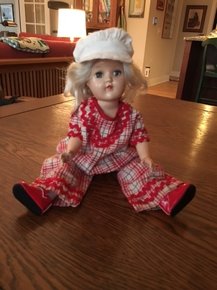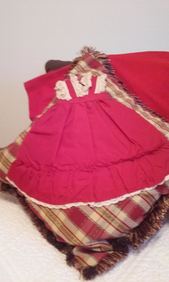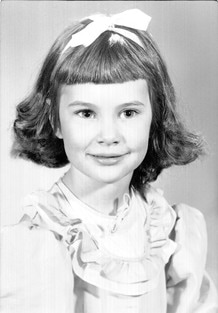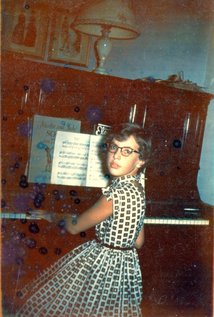My Toni is a model P90 - that is, 14” tall (the smallest Toni; the dolls also came in several larger sizes.) She has blue sleep-eyes lined with a fringe of upper lashes and painted lower lashes, a slightly pouty red mouth, a jointed body, and a platinum wig glued to her skull. Sadly, one of her hard plastic pinkies has broken off, but she is otherwise in pretty good shape. She was manufactured by the Ideal Toy Company sometime between 1949 and 1953, so I couldn’t have been more than ten when she and I began our long journey together, and more likely closer to six. I suppose I should display her on a stand and try to protect her from further damage, but my granddaughter loves to play with her and I love watching my granddaughter at play, so Toni’s fate is to lead the rough-and-tumble life of a child’s toy and not the pampered retirement of a collectible gathering dust on a shelf.
In addition to Toni herself, I have a whole wardrobe of clothes made by my mother using patterns from Butterick or McCall’s and material left over from clothes she made for us on her trusty old Kenmore electric home sewing machine (which I also still have, along with a set of bobbins and a box of lethal-looking attachments for ruffling, zigzagging, buttonholing, etc.). In fact, for a long time I had two of each outfit, one for Toni and one for her red-haired sister Nancy Lee, a slightly larger Arranbee doll with which I foolishly parted with when her arms and legs came off, not knowing at the time how easy it would have been for any “doll doctor” to reattach them. I no longer have Toni's original outfit, detracting from any value she might retain as a collectible, but the ones my mother made for me are far more precious.
In the past women had styled their hair with curling irons and, well, just plain irons, which all too often left their homes reeking of scorched hair. So the development of the permanent wave in the early twentieth century was embraced by many women, especially after the less elaborate cold wave was invented in 1938. But even though the alarming Rube Goldberg machines and strong heat of the old-style perms were no longer needed, the cold wave process still involved serious chemical changes to the protein structure of the hair and required six to eight hours in a salon.
The home permanent, pioneered by the Toni Home Permanent Company of Forest Lake, Minnesota, was thus a breakthrough product, offering a cheaper alternative to the salon perm and bringing hair styling back home again. It also made beauty a social occasion, with Toni parties becoming popular among both teenagers and adults.

Long hair and heavy machinery don't mix, and the employment of women in factories during World War II led to a call for shorter hairstyles. (The sultry actress Veronica Lake cut off her "peekaboo" locks to help promote workplace safety, and although her career suffered as a result, her sacrifice led to a measurable decline in industrial accidents.) The home perm was well adapted to these new styles and helped prolong a preference for soft waves or curls, often swept away from the face or paired with bangs.
Sleeker straighter hairstyles did not become fashionable till the 1960s, popularized by activists like Joan Baez, and my poor sister, who had the most adorable straight hair and bangs, was subjected in the name of beauty to a series of Tonettes, a Toni home perm intended especially for little girls. My own hair, on the other hand, was too curly. I desperately wanted to let it grow long, but my soft-hearted mother couldn’t bear the anguished tears produced by combing out my sausage curls and repeatedly dragged me off to a beauty parlor for a cringe-worthy do called the “cap cut.”





 RSS Feed
RSS Feed